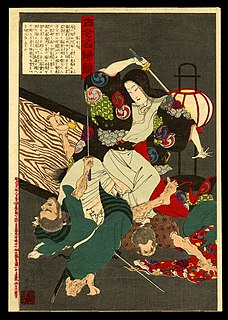Lady Kasuga

Lady Kasuga (春日局, Kasuga no Tsubone, 1579 – October 26, 1643) was from a prominent Japanese samurai family of the Azuchi–Momoyama and Edo periods. Born Saitō Fuku (斉藤福), she was a daughter of Saitō Toshimitsu (who was a retainer of Akechi Mitsuhide). She was the wet nurse of the third Tokugawa shōgun Iemitsu. Lady Kasuga was one of the best women politicians in the early modern period, such as standing in front of negotiations with the Imperial Court, and contributed to the stabilization of the Tokugawa Shogunate.
Life

Her mother's father was Inaba Yoshimichi. Married to Inaba Masanari, she had three sons, including Inaba Masakatsu, and an adopted son, Hotta Masatoshi. She was recommended to Tokugawa Ieyasu by Itakura Katsushige for the position of wet nurse for Tokugawa Iemitsu, but there is a theory that Ieyasu chose her on his own. She was chosen for the job as a payment because she helped persuade Kobayakawa Hideaki to join the Eastern Army in the Battle of Sekigahara.
She also established the Ōoku, the women's quarters, at Edo Castle. In 1607 after Iemitsu became shōgun, she became Jōrō Otoshiyori (上臈御年寄) or the senior ladyship, recommended by the first Midaidokoro, Oeyo. Jōrō Otoshiyori influence was equivalent to a Rōjū in Edo Castle.
In 1629, Ofuku traveled to the capital, where she had an audience with the emperor at the Imperial Court in Kyoto. She was promoted to the extraordinarily high Court rank of second class; and after this time, she was called Kasuga-no-Tsubone or Lady Kasuga. She had a fortune equivalent to over 100,000 koku.[1]
Death
Her grave is in Rinshō-in, a temple in Bunkyō, Tokyo; the temple possesses a portrait of Kasuga by Kanō Tan'yū. The Kasuga neighborhood of Bunkyō takes its name from her. Another grave is in Odawara, Kanagawa Prefecture.
Popular Culture
- Jotei Kasuga no Tsubone (1990, directed by Sadao Nakajima)
- Ōoku (2004) portrayed by Yuki Matsushita
- Kasuga no Tsubone (1989 NHK taiga drama) played by Reiko Ōhara.
- Basilisk: The Kouga Ninja Scrolls (2005 anime and manga) voiced by Kimiko Saitō.
See also
Notes
- ^ Murdock, James. (1996) A History of Japan, p. 3.
References
- Murdock, James. (1996) A History of Japan. London: Routledge.
External links
- Jotei: Kasuga no tsubone at IMDB
